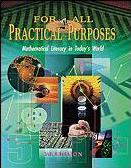'For All Practical Purposes'

For all Practical Purposes: Mathematical Literacy in Today's World
By COMAP
Reviewed by John Barrow (Director of the Millennium Mathematics Project)
This is one of the world's outstanding pedagogic texts. It has the rare distinction of being a mathematics book that has sold a million copies. The COMAP project is a coalition of leading mathematicians and educators, directed by Solomon Garfunkel, who over a period of twelve years and five ever-expanding editions have created a beautiful introduction to the practical applications of some of the most important areas of discrete mathematics.
This book is a text much used in the USA to support social scientists who need to know about the many important mathematical inputs into their subject areas. Its contents are especially interesting in that no calculus is assumed, required, or used. Yet it explains and applies a vast range of important mathematical ideas to concrete problems in business, social choice, apportionment, strategy, decision making, and design.
The key to the success of this book is the quality of the authors of the different chapters. Leading researchers in the focal subject areas have provided the individual chapters. The book is divided into twenty chapters, organised into five parts. Most of these chapters can be read as stand-alone expositions of their subject matter, or the separate parts can be enjoyed as short courses. The subjects treated are engagingly novel and most will not be seen by school students in the UK, or even by mathematics undergraduates unless they take appropriate options in the latter part of their course.
The first part of the book treats street networks with simple graph theory, travelling salesman problems and critical paths through complex multi-tasks, the mathematics of planning and scheduling, and linear programming. The second part is about probability and statistics, while part three covers check-digit security systems on credit cards and bank notes, ISBNs, universal product codes, modern cryptography, and information transmission. Part four is the most impressive, with clear thorough chapters about voting paradoxes and social choice, weighted voting systems, problems of fair division of resources - with a nice case study of the Trump divorce case, and (what should be required reading for all lawyers and election officials in the US) the theory of elections and voter representation and apportionment. This part ends with a 50-page chapter about game theory, beginning with simple 2-person games, but moving on to larger games and examples of many real-world applications.
These chapters are American in their case study focus but the principles they expound are general and universal in application.
The next part of the book focuses on size and shape and has chapters about scaling and proportion (with a heavy emphasis on biological examples), symmetry, patterns and tilings of the plane, which includes substantial discussions of the possible frieze and wallpaper designs together with the work of Escher and Penrose.
Finally, the curtain is brought down with two separate chapters on logic and consumer finance models.
Few of this galaxy of subjects can be found in such accessible forms elsewhere. Each subject is illuminated by many real-world applications and illustrated by examples drawn from the American media. The presentation is lavish, with colour used on every page, yet the real mathematics is still done. There are many problems (with solutions to the odd-numbered examples included) about real examples of the topics discussed in each chapter and many cross-references to books, articles, and websites. Further bonuses are separately listed projects on which to use computer or calculator skills and other writing projects for non-computer types. Nor are teachers forgotten. Supplementary packages are available for instructors, on-line testing is an option, videos and CDs cover wider aspects of the subject matter, and there is a website to support both students and instructors. Clement Durrell eat your heart out.
This book is exemplary. It shows what can be achieved by an alliance of first rate mathematicians, educators, designers, and publishers. The result is a treasure trove of fascinating real-world applications of mathematics that many high-school students would not even know existed. This is a book to fascinate A level students with mathematical interests and convince social science students that mathematics is vital for their subjects. It manages to solve the problem of making a seamless transition from the world of purely qualitative discussion of topical problems to their accessible mathematical treatment. This is the first book that I recommend to anyone seeking stimulating reading beyond the school curriculum. If you thought that mathematics leads only to physics and engineering then read this book. Even if you didn't, still read this book.
- Book details:
- For All Practical Purposes: Mathematical Literacy in Today's World, fifth edition
- COMAP
- Hardback - 800 pages (2000)
- W.H. Freeman
- ISBN: 0 7167 3817 1